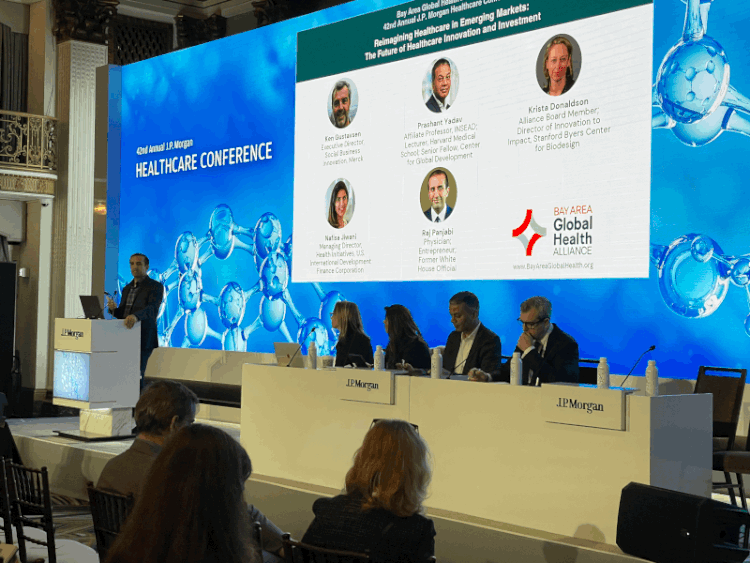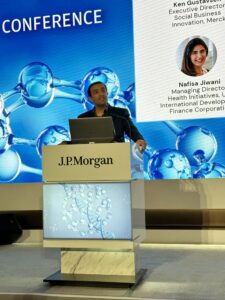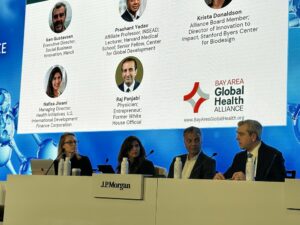“Illness is universal, health care is not, but if we reimagine the way we all show up to invest in healthcare and technology in emerging markets, I think we can change that.”
– Raj Panjabi, Former White House Senior Official, Physician, and Entrepreneur
You can access the panel discussion here.
On Wednesday, January 10, the Bay Area Global Health Alliance hosted a panel discussion, Reimagining Healthcare in Emerging Markets: The Future of Healthcare Innovation and Investment at the renowned J.P. Morgan Healthcare Conference in San Francisco.
The discussion presented a compelling — and practical — investment case for healthcare in emerging markets, as panelists shared thoughts on how and why it is possible to simultaneously achieve high returns on investments and contribute to global health equity.
Emerging markets are rapidly growing economies in low- to middle-income countries. Investors have traditionally been scared away from emerging economies, as they tend to have higher levels of risk and volatility, including political instability, underdeveloped regulatory frameworks, and risks associated with currency fluctuations.
Healthcare markets in these countries represent, however, a potential robust return on investment as populations grow and economies burgeon and become increasingly interconnected with global markets. And as our panelists noted, an emerging set of tools exists to help mitigate both perceived and real risks on the part of potential investors.
“Emerging markets represent the fastest-growing healthcare markets in the world.” — KRISTA DONALDSON, STANFORD BYERS CENTER FOR BIODESIGN
Kicking off the discussion, moderator Krista Donaldson, Alliance board member and director of Innovation to Impact at the Stanford University‘s Byers Center for Biodesign, noted that emerging markets are home to large populations of “digital natives. What is this going to mean for global markets?” she asked. “It is no surprise that emerging markets represent the fastest growing healthcare markets in the world.”
In his opening remarks, former White House senior official, physician, and entrepreneur Raj Panjabi highlighted three emerging markets health system trends. “First, fueled by Covid, the acceleration of digital health coupled with advancements in technology is paving the way for locally driven health tech innovation,” said Panjabi. “The integration of analytics, including artificial intelligence, is empowering entrepreneurs around the world to create companies that are poised to transform health systems in these very markets.”
A second trend, Panjabi noted, is “that emerging markets are home to the youngest and fastest growing populations in the world” and present healthcare opportunities in screening, diagnosis, prevention, and care delivery, as well as “new momentum in health technology innovation, from early patient identification to leveraging digital diagnostics, from AI-driven imaging to innovative work on genomics, from enhancing wellness and disease prevention to ensuring that we improve clinical outcomes.”
“Home-grown startups in emerging markets are already making a difference. These businesses are collectively increasing access and affordability of quality healthcare for billions of patients.” — RAJ PANJABI
A third — and perhaps the most important trend — Panjabi said, is that “home-grown startups in emerging markets are already making a difference. They’re doing real startup work, with businesses succeeding in places from Brazil and Mexico to Rwanda and to India. They’re developing innovations; they’re developing more effective therapies and delivering healthcare care through digital pharmacies. They’re building virtual health assistance and delivering and building tech-enabled supply chains. They’re driving innovations in value-based care arrangements and in health insurance, and they’re strengthening benefits administration and transparent pricing models. These businesses in emerging markets are collectively increasing access and affordability of quality healthcare for billions of patients.”Donaldson asked panelists to speak to what she called “the elephant in the room” or potential risks to healthcare investments in emerging markets, including “unreliable infrastructure, political and economic instability, limited and changing regulatory frameworks, limited data, insufficient workforce or insufficiently trained workforce.”
Ken Gustavsen, the Executive Director of Merck’s Social Business Innovation impact venture capital fund, said, “One observation is that I think 10 years ago we couldn’t be having this discussion.” He added, “Now, from our standpoint, we get the question a lot— are you impact first or are you return first? And my answer is usually, well — yes.” He noted that Merck no longer has to choose between social impact and financial returns on investment. “Although there might be a little bit of a tradeoff, we look at opportunities as mutually reinforcing social impact and financial return. The pandemic highlighted the shortcomings in global healthcare infrastructure. Governments are now much more motivated to respond. They’re devising and revising healthcare plans to better serve their citizens, and they’re investing more.”
“Although there might be a little bit of a tradeoff, we look at opportunities as mutually reinforcing social impact and financial return.” — KEN GUSTAVSEN, MERCK
Merck seeks opportunities in both direct investments and pooled fund investments that are strategically aligned with the company’s values, Gustavsen said. “We look at geographies where we are either currently operating or we might operate in the future because investments like these can build that infrastructure.” He added, “There might be insufficient infrastructure, but that’s a reason to invest. How can we build that infrastructure for the future?” For Merck, he said, such investment opportunities include digital health solutions, supply chain diagnostics, financial inclusion, health insurance, life insurance, and other payment mechanisms.
Prashant Yadav is a senior fellow at the Center for Global Development, an affiliate professor at INSEAD, and academic director of the INSEAD Africa Initiative. “I want to start by saying that innovation in biotech biopharma is global. That’s something we all have to accept. And while emerging markets start getting ready for innovation and the ecosystem for upstream science, on the downstream delivery science, a lot of innovation is already happening,” said Yadav.
Regulatory and payment fragmentation coupled with insufficient diagnostics and delivery infrastructure can seem overwhelming, said Yadav. “The real excitement in the last five years is that these challenges are being overcome by social entrepreneurs, entrepreneurs who are using new business models because they are from the region, the country, and they see the problem firsthand and they say, I’ve got to solve it. In solving it, they’re tapping into many different forms of capital, many different forms of technology, and many different forms of business models. In many cases, they are creating entirely new business models which will help us in overcoming similar barriers in other regions.”
“Challenges [regulatory, insufficient diagnostics, delivery infrastructure, etc.] are being overcome by social entrepreneurs. They are tapping into many different forms of capital and technology, and in many cases, they are creating entirely new business models which will help us in overcoming similar barriers in other regions.” — PRASHANT YADAV, INSEAD
Yadav noted advancements in diagnostics, including pathogen genomic sequencing and biobanking, and innovations in the delivery of products and services, citing the example of Zipline, a company that started in Rwanda and has now created the world’s largest drone delivery of health products system as a “clear example of a very investable company that got investments.”“The simple way to view this is that risk is high, or at least perceived risk is high. And the ability to price that risk is low — just because the willingness to pay or the ability to pay is not commensurate with the risk. That’s the equation that everybody faces, which is what dilutes the investment case in many such deals,” added Yadav. He further described instruments that are now available “to create the proverbial win-win type of equation.” Such tools include volume guarantee and highly concessional debt or loans from development banks.
Nafisa Jiwani is the managing director of health initiatives at one such development bank, the U.S. International Development Finance Corporation (DFC), where she manages the Health and Prosperity Initiative that seeks to mobilize capital to strengthen health systems and improve resilience in developing countries. Jiwani spoke of the exponential growth — and incredible opportunity — in emerging markets’ health systems over the past few years. “I’m in a position where I’m not having an issue in terms of my pipeline. I’m having an issue with getting money out the door fast enough,” she said, noting that the primary role of the DFC is to increase investment into emerging markets. The DFC, she added, has a suite of tools to help mitigate risks and the trepidation of potential investors.
“What we know and do best is debt financing and political risk insurance, which help companies that are looking to go into an emerging market have a little bit of security in going into that market,” Jiwani added. “It’s important because as you’re going into an emerging market, you do worry about whether or not there’s going to be instability.”
“The investments that we’re prioritizing fall into three different buckets,” said Jiwani. “The first is around health services and delivery. Anything that is infrastructure, that could be a hospital, it could be a clinic, it could be a dialysis center. Anything that’s brick and mortar, that’s our first. The second priority is really around manufacturing and supply chain … And what’s exciting is because we’re building that portfolio, there is a need to now build an entire ecosystem to support a biotech sector in different parts of the world that just wasn’t there before.” The third bucket, Jiwani said, is “at the intersection of health and technology.”
“I’m in a position where I’m not having an issue in terms of my pipeline. I’m having an issue with getting money out the door fast enough…. The investments that we’re prioritizing fall into three different buckets: health services and delivery, manufacturing and supply chain, and the intersection of health and technology.” — NAFISA JIWANI, DFC
Jiwani noted that “the job of the DFC is to talk to the private sector.” She encourages would-be investors to contact her. “I’d rather you come to me and say, can we do this? And we start having a dialogue about the types of investments that we’re looking at. I’ll give you a sense of what our eligibility requirements are; we’re very transparent.”
Speaking from the audience, participant Shabnam Vaezzadeh asked panelists if models from emerging markets could be applied to improve healthcare in more developed countries.
“I think the short answer is absolutely yes,” said Gustavsen. “We’ve seen examples in our portfolio of companies that are operating in dual markets and providing their solutions in the developing world and in the developed world, sometimes moving directly from the developing world to the developed world. And oftentimes, they’re doing that with a solution that was created in a resource-constrained setting, in a more necessarily innovative setting. So then when it comes to a developed setting, it’s even that much more efficient and cost-effective.” He described a recent investment in a highly effective and simple cataract surgery technology in East Africa, an investment that was bought by a global optics company for use throughout the world.
”We almost ignore the changes in emerging markets at our peril,” said Donaldson before asking the panelists what they are most excited about regarding healthcare investment opportunities in emerging markets.
Gustavsen said that he is “excited to see what’s going to come next because the range of investment opportunities continues to grow at an exponential rate and seeing where those opportunities are and seeing the kind of transformational impact they will have in the developing world. And then to that last question, in the developed world as well.”
“I look forward to the transformational impact these opportunities will have in the developing world and in the developed world.” — KEN GUSTAVSEN
“I’m most excited about new delivery systems, which once again will serve other markets in the future. And when I say delivery systems, not just how you get products to patients, but also new delivery mechanisms and devices,” said Yadav.
“I am incredibly encouraged and excited about building out the biotech ecosystem across the world. I think it’s an incredible opportunity, and we’re seeing a lot of advancement really quickly,” adding that “people said that we would never have vaccine manufacturing on the [African] continent the way that we’re seeing now. Big surprise. And I think that there’s just an opportunity for us to do so much more, so much more,” said Jiwani.
Panelists:

Ken Gustavsen, Executive Director, Social Business Innovation, Merck.
Ken Gustavsen is the Executive Director of Social Business Innovation at Merck, where he manages the company’s venture capital impact investing portfolio and coordinates the Social Business Innovation global engagement team. He has been at Merck since 2000 in a variety of roles, with a focus on innovative approaches to expanding access to healthcare in the developing world and emerging markets. Before joining Merck, Ken led a post-war relief and development program in Kosovo for the non-profit organization World Relief, involving microfinance banking and housing reconstruction. Prior to World Relief, Ken served for 6 years in the United States Navy in a variety of assignments. Ken received a BS in oceanography from the United States Naval Academy, holds an MBA in finance and global business from Rutgers University, and completed the Advanced Finance Program at the Wharton School.

Nafisa Jiwani, Managing Director, Health Initiatives, U.S. International Development Finance Corporation.
Nafisa Jiwani is Managing Director for Health Initiatives at the U.S. International Development Finance Corporation (DFC), America’s development bank. As a Managing Director, Jiwani serves as a senior adviser to the agency’s Chief Executive Officer, providing guidance and leadership on policy and transactional matters focused on Global Health. Additionally, Jiwani is spearheading DFC’s Health and Prosperity Initiative, which seeks to mobilize capital to strengthen health systems and improve resiliency in developing countries. Prior to joining the agency, Jiwani served as the Deputy Senior Advisor to the Secretary of Health and Human Services on Value-Based Care where she led strategic department-wide priorities on maternal morbidity and mortality, sepsis and kidney care, social determinants of health and artificial intelligence/predictive analytics. Before taking her role at HHS, Jiwani worked at the Centers for Disease Control and Prevention (CDC) as a Team Lead for Policy and Partnerships in the Office of the Associate Director for Policy and Strategy. During her time at CDC, she focused her efforts on health systems transformation and was responsible for translating evidence into payment policy. Jiwani’s previous experience includes work in the fields of international development, clinical psychiatry research, youth development and newborn screening translational research. Jiwani earned a Bachelor of Arts degree in Psychology from Southern Methodist University and a Master of Public Health in Management and Policy degree from the Rollins School of Public Health, Emory University.

Prashant Yadav, Senior Fellow, Center for Global Development; Affiliate Professor, INSEAD; Lecturer, Harvard Medical School.
Prashant Yadav is a Senior Fellow at the Center for Global Development, an Affiliate Professor at INSEAD, and a Lecturer at Harvard Medical School. Prashant Yadav is a globally recognized scholar in the area of healthcare supply chains. He is the author of many peer-reviewed scientific publications and his work has also been featured in prominent print and broadcast media including The Economist, The Financial Times, Nature, and BBC. Prashant Yadav is a senior fellow at the Center for Global Development and Affiliate Professor of Technology and Operations Management at INSEAD. Yadav’s work focuses on improving healthcare supply chains and designing better supply chains for products with social benefits. He is the author of many peer reviewed scientific publications and his work has been featured in prominent print and broadcast media including The Economist, The Financial Times, Nature, and BBC. Yadav’s research papers have been the recipient of best paper awards from the Production and Operations Management Society, INFORMS, and scientific bodies. Over the last 15 years, Yadav has worked closely with multiple country governments and global organizations in improving supply chains for medicines and health products. Yadav’s policy advisory roles have included: Strategy Leader-Supply Chain at the Bill & Melinda Gates Foundation, Chair of the Market Dynamics Advisory Group of the Global Fund, Co-chair of Procurement & Supply Chain Management at the Roll Back Malaria Partnership, Commissioner on the Lancet Commission on Essential Medicines. Yadav has been invited for expert testimony on issues related to medicine supply chains in the US Congress and legislative bodies in other countries. Yadav also serves on the advisory boards of many global organizations and social enterprises. In his previous roles, Yadav has worked as Strategy Leader-Supply Chain at the Bill & Melinda Gates Foundation; Vice President of Healthcare at the William Davidson Institute and Faculty at the Ross School of Business at the University of Michigan; Professor of Supply Chain Management at the MIT-Zaragoza International Logistics Program and Research Affiliate at the MIT Center for Transportation and Logistics.
Moderator:

Krista Donaldson, Alliance Board Member; Director of Innovation to Impact, Stanford University Byers Center for Biodesign.
The panel was moderated by Alliance Board Member, Krista Donaldson, Director of Innovation to Impact at Stanford University‘s Byers Center for Biodesign. Donaldson is an engineer, designer, author, and entrepreneur who has been recognized as a World Economic Forum Technology Pioneer, TED speaker, and a GLG Social Impact Fellow. She was also named one of Fast Company’s “50 Designers Shaping the Future.” Donaldson is the Director of Innovation to Impact at Stanford University’s Byers Center for Biodesign, where her work focuses on ensuring design tools and processes are broadly applicable across global markets. She is also part of the team establishing the East Africa Biodesign Program at the University of Global Health Equity in Rwanda. In addition to her work at Stanford she serves on a number of boards and works with organizations to promote financing of local medtech innovation in emerging markets. Prior to joining the Byers Center, Donaldson was the founder and CEO of Equalize Health where she addressed health inequities through the design and scaling of disruptive medical devices that treated over 1.8M patients – mostly children and young people – in 80 countries. Equalize Health filled a critical gap in global health by bridging innovation with global distribution to ensure that solutions sustainably reached the people who needed them. Peter Singer of the Effective Altruism movement called Equalize Health “one of the world’s best charities” because of its cost effectiveness and exemplary end-to-end processes. Donaldson also served as an Economic Officer at the U.S. Department of State where she managed part of Iraq’s reconstruction portfolio, co-founded the startup Safehub (acquired by Bitium, USA), designed water pumps at KickStart International (Kenya) and worked on a range of projects at the design firm IDEO (USA). Donaldson holds a BS in Mechanical Engineering, magna cum laude, from Vanderbilt University, master’s degrees in Product Design and Mechanical Engineering from Stanford University, and a Ph.D. in Mechanical Engineering, also from Stanford. She has published widely in design, global health, mechanical engineering, and engineering education, and is on the boards of the Bay Area Global Health Alliance and Design for Good. Originally from Nova Scotia, Canada, she now lives with her family in San Francisco, CA.
With Opening Remarks:

Raj Panjabi, former White House Senior Director.
Raj Panjabi, renowned physician, entrepreneur, former White House official, and one of TIME’s 100 Most Influential People in the World, provided opening remarks.
Dr. Panjabi served as White House Senior Director, leading the pandemic and biological threats office for President Biden at the National Security Council. He played a pivotal role in the largest global vaccination campaign in history against COVID-19 and numerous infectious disease outbreak responses. He oversaw White House efforts to prevent the next pandemic, including playing a lead role in implementing the National Biodefense Strategy, American Pandemic Preparedness Plan, President’s Executive Order on Advancing Biotechnology and Biomanufacturing, and the U.S. Global Health Security Act. Panjabi also led the U.S. President’s Malaria Initiative.
Panjabi is Entrepreneur In Residence at Emerson Collective, co-founder at Last Mile Health, and on the faculty at Harvard Medical School and Brigham & Women’s Hospital. Twice listed as one of the World’s 50 Greatest Leaders by FORTUNE and named one of TIME’s 50 Most Influential People in Healthcare, Panjabi has received the TED Prize, Clinton Global Citizen Award, Skoll Award for Social Innovation, and World Economic Forum’s Social Entrepreneur of the Year. Panjabi trained in medicine and public health at the University of North Carolina, Johns Hopkins University, Harvard Medical School and Massachusetts General Hospital.









